14th August 2007 - Mixed results from a difficult growing year
My grand plan to have colour schemed beds this year has not been the roaring success that I was hoping for. Partly, it’s been the soaking June and July – many flowers were battered into submission by the rain and simply didn’t look their best, if they flowered at all. Then there was the explosion in the slug and snail population which took a serious toll during the rain.
"The slugs and snails managed to eat their way through a good few plants..."
The slugs and snails managed to eat their way through a good few plants that I had hoped would add to the schemes and with it being so wet, with no improvement in sight at the time, I didn’t replace them. Now that the weather has cleared up, I could go out and buy replacements.
Later: no suitable Achilleas available as most have gone over but I did find a Sedum rupestre ‘Angelina’, low growing and with golden-orange-green foliage. Perfect ground cover for the orange-yellow-green bed. Also found two for the ‘hot’ bed, both Crocosmia x crocosmifolia - one is tomato red with dark foliage and is called ‘Saracen’, the other is golden yellow with green foliage and is called ‘Honeybells’.
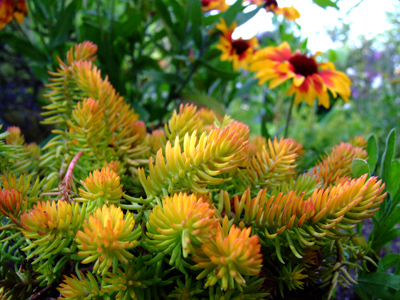
Sedum rupestre 'Angelina'
To the list of casualties – Achillea 'Walther Funcke' simply disappeared during the heavy rain, eaten by slugs and snails; Eschscholzia californica became weak and leggy, although it’s starting to recover; the flowers of Astrantia major ‘Hadspen’s Blood’ turned into a soggy mess; some huge and glorious red and black poppies were totally slugged, even though they are supposed to be hairy enough to put the slugs off. They have disappeared without trace. The Hemerocallis sagged under the weight of water and the flowers turned to mush. Many of the Linaria purpurea flowers turned brown before opening, as did the Sisyrinchium striatum, which also flopped over; the Aconitum napellus all fell over, too, during one especially heavy downpour (the same one that flooded Hull, which is just up the road from here).
Cornus sanguinea ‘Midwinter Fire’ seems to have developed a possibly fatal dose of Dogwood Anthracnose and may have to go. I’ve cut it back hard and will see how it gets on when it leafs out again. Much of the Malva moschata ‘Alba’, so lovely last year, has gone brown but some of the plants seem okay. The Cleome spinosa seeds, sent to by a friend and which had come on so well in pots and were about 30cm high, lasted all of a week before being chewed to the ground. The stems are prickly and you wouldn’t have thought them attractive to slugs, but they’re obviously delicious.
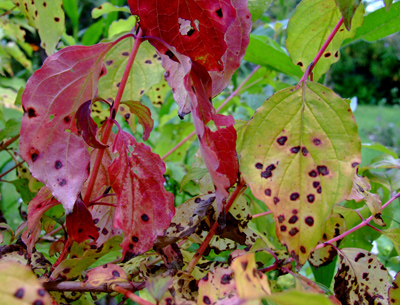
Dogwood Anthracnose?
It isn’t all bad, of course, as other things have benefited from the soaking. The Helenium autumnale look like being good this year and so do the Rudbeckia ‘Goldsturm’. To my surprise, I found some seedlings of Rudbeckia hirta popping up, which are just breaking into flower. I haven’t had these in the ground since 2004 and wonder what stimulated germination. The purple leaved Heucheras have also bulked up nicely; Lysimachia ciliata 'Firecracker' is better than ever and has more flowers than usual and all the Crocosmias have done well. Sedum spurium 'Green Mantle' also seems to have benefited from the wet and the divisions I put in earlier this year are bulking up nicely.
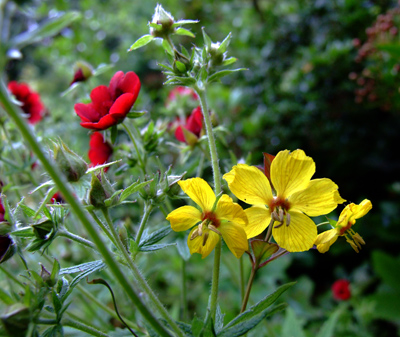
Lysimachia ciliata 'Firecracker' with Potentilla 'Monarch's Velvet'
Apart from the sad looking Cornus sanguinea ‘Midwinter Fire’, all the other shrubs have been given a boost and have grown quite a lot. The dogwoods (C. alba 'Elegantissima' and Cornus stolonifera ‘Flaviramea’) on the edge of the patio, that we put in as a privacy screen, have grown at an amazing rate and must have grown at least a metre since March. They now provide a pleasing screen between the house and garden and the road beyond, but without being a solid barrier. This is exactly what we wanted and we’ve been using the patio more than we ever have done before, feeling both comfortable and sheltered.
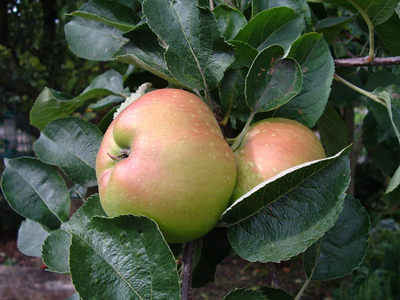
Ripe apples
The apple tree has a mass of fruit and hasn’t dropped as much as it did last year or the year before. I’ve noticed this with other apple trees around and about, which are all heavy with fruit. Hazelnut trees are the same; in fact, I’ve never seen so many nuts on the trees over the road.
When I had my day out with a friend the other week, we walked along a country road and were amazed at the number of cherries on the trees. Every 30 metres or so was a mature cherry tree, each laden with fruit, all of which was ripe and busting with sweet juice. We couldn't understand why the fruit was still on the trees, why they hadn't been picked by humans or eaten by birds.
It was like stepping into the edge of Eden, as we walked along in the warm sunshine, picking this perfect fruit, our fingers purple with juice.
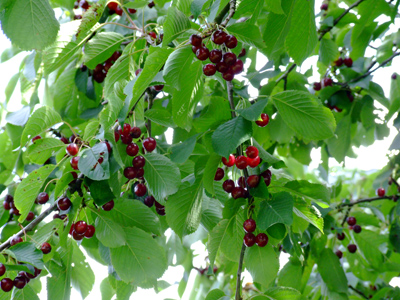
Some of the wonderful cherries
So, in all, it could have been a lot worse. It hasn't been an easy growing year and the garden ended up very soggy, but we weren’t flooded so have much to be grateful for in that quarter, and now it’s recovering fairly well. A week of sunshine has passed and many of the plants are picking up again; a few more weeks of fine weather will hopefully bring more colour.
© Copyright Miranda Hodgson 2007